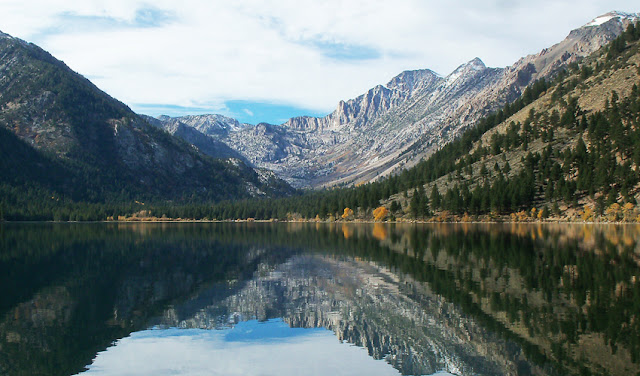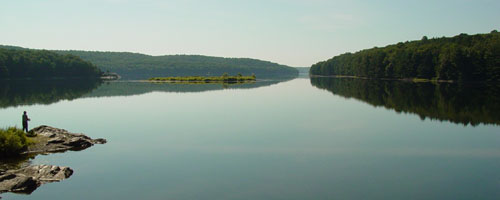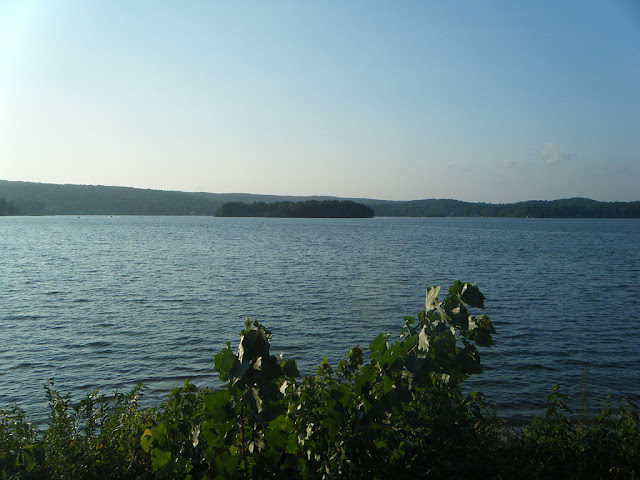Twin Lakes of Connecticut
The Twin Lakes of Salisbury, Connecticut are Lakes Washinee and Washining, whose supposed identities as twins seem in conflict with their dissimilar size and shape. However, they are called the "twin lakes" not because of their size and shape, but because of their namesakes, two daughters of a Mahican chief. Twin Lakes is also home to the world-renowned, executive private club, "Twin Lakes Beach Club".
Etichete:
Lakes of Connecticut
Lakes of the United States
Twin Lakes, WI, USA
Squantz Pond of Connecticut
Lying in the Fairfield County towns of Sherman and New Fairfield, Squantz Pond is part of Candlewood Lake but is separated from the main body of the lake by Route 39. Squantz Pond is natural in origin; however, its level was raised when Candlewood Lake was impounded in 1923. The lake has a surface area of approximately 288 acres (1.2 km²), a maximum depth of 47 feet (14 m), an average depth of 22.9 feet (7 m), and holds approximately 2 billion US gallons (7,600,000 m³) of water.
The shoreline bottom materials consist mostly of rocks, ledge, and gravel. Mud and organic muck cover the relatively flat areas of the bottom. The lake is fed by Glen Brook from the north, Worden Brook from the west, and several small unnamed streams.
The watershed of Squantz Pond is 3,635 acres (15 km²). Woodlands, wetlands, and water comprise approximately 80 percent of the watershed, 15 percent is moderate to low-density housing, while the remaining 5 percent is open land and farm land.
The eastern shoreline is developed with homes, while the western shoreline is steep and wooded. The southwestern shoreline borders Squantz Pond State Park. Facilities in the park include concession stands, picnic areas, beach and swimming areas, toilets, and hiking trails.
Public access to Squantz Pond is provided through a state owned boat launch located in the State Park. Boats launched from the State Park are limited to a maximum of 7.5 horsepower (6 kW). The launch can be reached by taking Interstate 84, Exit 5 to Route 37 north, to Route 39 north to the State Park entrance.
The launch has a ramp of concrete pads with an asphalt approach. There is parking for 25 cars at the launch.
An aquatic survey of Squantz Pond was published in 1988. The survey found aquatic vegetation in Squantz Pond to be sparse and limited to the shallower areas in the northern section. Species observed included Bushy pondweed (Najas flexilis, Najas minor), Bulrush (Scirpus sp.), and cattail (Typha sp.)
The Connecticut Department of Environmental Protection periodically stocks both brown and rainbow trout in Squantz Pond. Other species found in the lake include Largemouth Bass, Yellow Perch, White Perch, Walleye, and Chain Pickerel.
The current Connecticut Angler's Guide has specific fish consumption advisory information, as well as, the most recent rules governing sport fishing.
SOURCE - Connecticut Department of Environmental Protection Copyright 1998-2004
Etichete:
Lakes of Connecticut
Lakes of the United States
Squantz Pond, Connecticut, USA
Saugatuck Reservoir of Connecticut
The Saugatuck Reservoir is a reservoir in Fairfield County, Connecticut, US, that straddles the border between the towns of Redding and Weston. It is created by the Samuel P. Senior dam of the Saugatuck River, and provides water to several of the surrounding towns. It is considered quite scenic and is stocked with trout for fishing. It borders the Devil's Den Preserve in the southwest.
Bridgeport Hydraulic Company Holdings (now owned by Aquarion) flooded the Saugatuck River Valley after 1938 displacing the village of Valley Forge to create the Saugatuck Reservoir.
Aquarion Water Co., owner of the reservoir and dam, allows tailrace fishing in one area at the Weston end of the reservoir, where it has constructed a handicapped-access area. However, anglers must obtain a permit from Aquarion before fishing in the Saugatuck.
The Saugatuck is the largest of the eight reservoirs that make up Aquarion’s greater Bridgeport water system. It holds about 12 billion US gallons (45,000,000 m3) of water.
The following fish species may be found within the Saugatuck Reservoir:
American eel
Bluegill (Sunfish)
Brook trout
Brown trout
Bullhead catfish
Chain pickerel
Crappie
Largemouth bass
Pumpkinseed (Sunfish)
Rainbow trout
Rock bass
Smallmouth bass
Walleye
White perch
Yellow perch
Etichete:
Lakes of Connecticut
Lakes of the United States
Saugatuck Reservoir, Connecticut, USA
Lake Saltonstall of Connecticut
Lake Saltonstall is a long narrow lake located in south-central Connecticut. It covers an area of approximately 0.66 square miles (1.7 km2) and is nestled in the center of the trap rock Saltonstall Mountain. The lake is surrounded by forest and serves as part of the local water supply for surrounding towns.
The lake and the area around it is owned by the South Central Connecticut Regional Water Authority, a company which also regulates fishing and rents boats. Private boats are not allowed.
Interstate 95 runs across the southern edge of the lake, connecting the towns of East Haven, Connecticut and Branford, Connecticut.
Lake Saltonstall's maximum depth does not exceed 113 feet (34 m) and its mean depth is 41 feet (12 m).
Etichete:
Lakes of Connecticut
Lakes of the United States
Lake Saltonstall, Connecticut, USA
Lake Pocotopaug of Connecticut
Lake Pocotopaug is a village and census-designated place (CDP) in the Town of East Hampton in Middlesex County, Connecticut, United States.
It is named for the large local lake, which for years has been a popular resort area. The lake is surrounded by numerous homes. Most are year round residences, although some summer cottages dot the shore. It is especially noted for two islands in its center, separated by a narrow, shallow strait (both of which have cabins).
The lake's name comes from the local Pequot Indian word for "lake with pierced islands". Some time long before the area was settled by whites, the tribe living there felt they were being cursed by their irritable Great Spirit. To try and appease him, the main chief agreed to sacrifice his daughter, who willingly threw herself into the lake and drowned. The tribe's shamans announced that never again would an Indian be killed on the lake.
Lake Pocotopaug at 512 acres, is large, but many other lakes in Connecticut are larger. The largest by far, is Candlewood Lake at 5064 acres.
The Indians were also known to have hunted on Spellman's point, a quaint street lined with cottages, using loud noises to scare the animals to the end of the peninsula, and thereby an effective way to gather food, however in the mid-to-late 1800s it was sold for a sack of bean to the "Bay point" society.
Sears Park is located at the lake and has various swimming, boating and recreational facilities for residents.
In recent years the lake has become a place of ecological study due to the large scale algae blooms that resulted in 2000. Tests have shown that longstanding shoreline development and fertilizer use are causing increasing issues. A town sanctioned Lake Commission and the Friends of Lake Pocotopaug are two organizations concentrating on improvement ideas.
Etichete:
Lakes of Connecticut
Lakes of the United States
Lake Pocotopaug, East Hampton, CT 06424, USA
Subscribe to:
Posts (Atom)















